
A toothbrush is an oral hygiene tool used to clean the teeth, gums, and tongue. It consists of a head of tightly clustered bristles, atop of which toothpaste can be applied, mounted on a handle which facilitates the cleaning of hard-to-reach areas of the mouth. They should be used in conjunction with something to clean between the teeth where the bristles of the toothbrush cannot reach - for example floss, tape or interdental brushes.
They are available with different bristle textures, sizes, and forms. Most dentists recommend using a soft toothbrush since hard-bristled toothbrushes can damage tooth enamel and irritate the gums. [1]
Because many common and effective ingredients in toothpaste are harmful if swallowed in large doses and instead should be spat out, the act of brushing teeth is most often done at a sink within the kitchen or bathroom, where the brush may be rinsed off afterwards to remove any debris remaining and then dried to reduce conditions ideal for bacterial growth (and, if it is a wooden toothbrush, mold as well).
Some toothbrushes have plant-based handles, often bamboo. However, numerous others are made of cheap plastic; such brushes constitute a significant source of pollution. [2] [3] Over 1 billion toothbrushes are disposed of into landfills annually in the United States alone. [4] Bristles are commonly made of nylon (which, while not biodegradable, as plastic is, may still be recycled) or bamboo viscose.
History
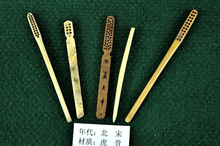

Precursors
Before the invention of the toothbrush, a variety of oral hygiene measures had been used. [6] This has been verified by excavations during which tree twigs, bird feathers, animal bones and porcupine quills were recovered.
The predecessor of the toothbrush is the chew stick. Chew sticks were twigs with frayed ends used to brush the teeth [7] while the other end was used as a toothpick. [8] The earliest chew sticks were discovered in Sumer in southern Mesopotamia in 3500 BC, [8] an Egyptian tomb dating from 3000 BC, [7] and mentioned in Chinese records dating from 1600 BC.
The Indian way of using tooth wood for brushing is presented by the Chinese Monk Yijing (635–713 CE) when he describes the rules for monks in his book: [9] "Every day in the morning, a monk must chew a piece of tooth wood to brush his teeth and scrape his tongue, and this must be done in the proper way. Only after one has washed one's hands and mouth may one make salutations. Otherwise both the saluter and the saluted are at fault. In Sanskrit, the tooth wood is known as the dantakastha—danta meaning tooth, and kastha, a piece of wood. It is twelve finger-widths in length. The shortest is not less than eight finger-widths long, resembling the little finger in size. Chew one end of the wood well for a long while and then brush the teeth with it."
The Greeks and Romans used toothpicks to clean their teeth, and toothpick-like twigs have been excavated in Qin dynasty tombs. [8] Chew sticks remain common in Africa, [10] the rural Southern United States, [7] and in the Islamic world the use of chewing stick miswak is considered a pious action and has been prescribed to be used before every prayer five times a day. [11] Miswaks have been used by Muslims since the 7th century.[ citation needed] Twigs of Neem Tree have been used by ancient Indians. [12] [13] Neem, in its full bloom, can aid in healing by keeping the area clean and disinfected. In fact, even today, Neem twigs called datun are used for brushing teeth in India, although not hugely common. [14]
Toothbrush
The first bristle toothbrush resembling the modern one was found in China. [15] Used during the Tang dynasty (619–907), it consisted of hog bristles. [16] The bristles were sourced from hogs living in Siberia and northern China because the colder temperatures provided firmer bristles. They were attached to a handle manufactured from bamboo or bone, forming a toothbrush. [7] In 1223, Japanese Zen master Dōgen Kigen recorded in his Shōbōgenzō that he saw monks in China clean their teeth with brushes made of horsetail hairs attached to an oxbone handle. The bristle toothbrush spread to Europe, brought from China to Europe by travellers. [17] It was adopted in Europe during the 17th century. [18] The earliest identified use of the word toothbrush in English was in the autobiography of Anthony Wood who wrote in 1690 that he had bought a toothbrush from J. Barret. [19] Europeans found the hog bristle toothbrushes imported from China too firm and preferred softer bristle toothbrushes made from horsehair. [7] Mass-produced toothbrushes made with horse or boar bristle continued to be imported to Britain from China until the mid 20th century. [6]
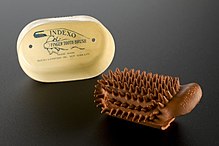

In the UK, William Addis is believed to have produced the first mass-produced toothbrush in 1780. [17] [20] In 1770, he had been jailed for causing a riot. While in prison he decided that using a rag with soot and salt on the teeth was ineffective and could be improved. After saving a small bone from a meal, he drilled small holes into the bone and tied into the bone tufts of bristles that he had obtained from one of the guards, passed the tufts of bristle through the holes in the bone and sealed the holes with glue. After his release, he became wealthy after starting a business manufacturing toothbrushes. He died in 1808, bequeathing the business to his eldest son. It remained within family ownership until 1996. [21] Under the name Wisdom Toothbrushes, the company now manufactures 70 million toothbrushes per year in the UK. [22] By 1840 toothbrushes were being mass-produced in Britain, France, Germany, and Japan. [23] Pig bristles were used for cheaper toothbrushes and badger hair for the more expensive ones. [23]
Hertford Museum in Hertford, UK, holds approximately 5000 brushes that make up part of the Addis Collection. The Addis factory on Ware Road was a major employer in the town until 1996. Since the closure of the factory, Hertford Museum has received photographs and documents relating to the archive, and collected oral histories from former employees. [24]
The first patent for a toothbrush was granted to H.N. Wadsworth in 1857 (U.S.A. Patent No. 18,653) in the United States, but mass production in the United States did not start until 1885. The improved design had a bone handle with holes bored into it for the Siberian boar hair bristles. Unfortunately, animal bristle was not an ideal material as it retained bacteria, did not dry efficiently and the bristles often fell out. In addition to bone, handles were made of wood or ivory. [25] In the United States, brushing teeth did not become routine until after World War II, when American soldiers had to clean their teeth daily. [20]

During the 1900s, celluloid gradually replaced bone handles. [15] Natural animal bristles were also replaced by synthetic fibers, usually nylon, by DuPont in 1938. The first nylon bristle toothbrush made with nylon yarn went on sale on February 24, 1938. The first electric toothbrush, the Broxodent, was invented in Switzerland in 1954. [26] By the turn of the 21st century nylon had come to be widely used for the bristles and the handles were usually molded from thermoplastic materials. [6]
Johnson & Johnson, a leading medical supplies firm, introduced the " Reach" toothbrush in 1977. [27] It differed from previous toothbrushes in three ways: it had an angled head, similar to dental instruments, to reach back teeth; the bristles were concentrated more closely than usual to clean each tooth of potentially cariogenic (cavity-causing) materials; and the outer bristles were longer and softer than the inner bristles. Other manufacturers soon followed with other designs aimed at improving effectiveness. [28] In spite of the changes with the number of tufts and the spacing, the handle form and design, the bristles were still straight and difficult to maneuver. In 1978 Dr. George C. Collis developed the Collis Curve toothbrush which was the first toothbrush to have curved bristles. The curved bristles follow the curvature of the teeth and safely reach in between the teeth and into the sulcular areas. [29]
In January 2003, the toothbrush was selected as the number one invention Americans could not live without according to the Lemelson- MIT Invention Index. [30]
Types of toothbrush
Multi-sided toothbrushes
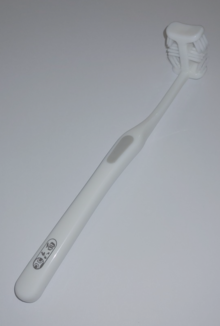
A multi-sided toothbrush is a fast and easy way to brush the teeth.
Electric toothbrush
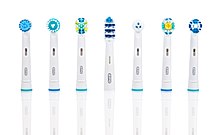
It has been discovered that compared to a manual brush, the multi-directional power brush might reduce the incidence of gingivitis and plaque, when compared to regular side-to-side brushing. These brushes tend to be more costly and damaging to the environment when compared to manual toothbrushes. [31] Most studies report performances equivalent to those of manual brushings, possibly with a decrease in plaque and gingivitis. [32] An additional timer and pressure sensors can encourage a more efficient cleaning process. [33] Electric toothbrushes can be classified, according to the speed of their movements as: standard power toothbrushes, sonic toothbrushes, or ultrasonic toothbrushes. Any electric toothbrush is technically a powered toothbrush. If the motion of the toothbrush is sufficiently rapid to produce a hum in the audible frequency range (20 Hz to 20,000 Hz), it can be classified as a sonic toothbrush. Any electric toothbrush with movement faster than this limit can be classified as an ultrasonic toothbrush. Certain ultrasonic toothbrushes, such as the Megasonex and the Ultreo, have both sonic and ultrasonic movements.
There are different electric toothbrush heads designed for sensitive teeth and gums, increased stain removal, or different-sized bristles for tight or gapped teeth. The hand motion with an electric toothbrush is different from a manual toothbrush. They are meant to have the bristles do the work by just placing and moving the toothbrush. Fewer back and forth strokes are needed. [34]
Interdental brush
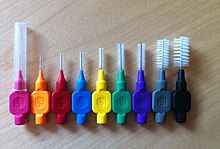

An interdental or interproximal ("proxy") brush is a small brush, typically disposable, either supplied with a reusable angled plastic handle or an integral handle, used for cleaning between teeth and between the wires of dental braces and the teeth.
The use of interdental brushes in conjunction with tooth brushing has been shown to reduce both the amount of plaque and the incidence of gingivitis when compared to tooth brushing alone. [35] Although there is some evidence that after tooth brushing with a conventional tooth brush, interdental brushes remove more plaque than dental floss, [36] a systematic review reported insufficient evidence to determine such an association. [35]
The size of interdental brushes is standardized in ISO 16409. [37] [38] The brush size, [39] which is a number between 0 (small space between teeth) and 8 (large space), indicates the passage hole diameter. This corresponds to the space between two teeth that is just sufficient for the brush to go through without bending the wire. The color of the brushes differs between producers. The same is the case with respect to the wire diameter. [40]
| Brush size | 0 [41] | 1 [42] | 2 | 3 | 4 | 5 | 6 | 7 [43] | 8 [43] |
|---|---|---|---|---|---|---|---|---|---|
| Passage hole diameter in mm | ≤ 0.6 | 0.7–0.8 | 0.9–1.0 | 1.1–1.2 | 1.3–1.5 | 1.6–1.8 | 1.9–2.3 | 2.4–2.8 | ≥ 2.8 |
End-tuft brush
The small round brush head comprises seven tufts of tightly packed soft nylon bristles, trimmed so the bristles in the center can reach deeper into small spaces. The brush handle is ergonomically designed for a firm grip, giving the control and precision necessary to clean where most other cleaning aids cannot reach. [44] These areas include the posterior of the wisdom teeth (third molars), orthodontic structures (braces), crowded teeth, and tooth surfaces that are next to missing teeth. It can also be used to clean areas around implants, bridges, dentures and other appliances. [45]
Chewable toothbrush
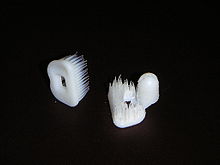
A chewable toothbrush is a miniature plastic moulded toothbrush which can be placed inside the mouth. While not commonly used, they are useful to travelers and are sometimes available from bathroom vending machines. They are available in different flavors such as mint or bubblegum and should be disposed of after use. Other types of disposable toothbrushes include those that contain a small breakable plastic ball of toothpaste on the bristles, which can be used without water. [46]
Musical toothbrush
A musical toothbrush is a type of manual or powered toothbrush designed to make tooth brushing habit more interesting. It is more commonly introduced to children to gain their attention and positively influence their tooth brushing behavior. The music starts while child starts brushing, it continuously plays during the brushing and it ends when the child stops brushing. [47]
Toothpaste-less toothbrush

Reusable toothbrush

Tooth brushing
Hygiene and care
It is not recommended to share toothbrushes with others, since besides general hygienic concerns, there is a risk of transmitting diseases that are typically transmittable by blood, such as Hepatitis C. [48]
After use, it is advisable to rinse the toothbrush with water, shake it off and let the toothbrush dry.
Studies have shown that brushing to remove dental plaque more often than every 48 hours is enough to maintain gum and tooth health. Tooth brushing can remove plaque up to one millimeter below the gum line, and each person has a habitual brushing method, so more frequent brushing does not cover additional parts of the teeth or mouth. [49] Most dentists recommended patients brush twice a day in the hope that more frequent brushing would clean more areas of the mouth. [50] Tooth brushing is the most common preventive healthcare activity, but tooth and gum disease remain high, since lay people clean at most 40% of their tooth margins at the gum line. Videos show that even when asked to brush their best, they do not know how to clean effectively. [51]
Adversity of toothbrushes
Teeth can be damaged by several factors including poor oral hygiene, but also by wrong oral hygiene. Especially for sensitive teeth, damage to dentin and gums can be prevented by several measures [52] including a correct brushing technique.
It is beneficial, when using a straight bristled brush, not to scrub horizontally over the necks of teeth, not to press the brush too hard against the teeth, to choose a toothpaste that is not too abrasive, [53] and to wait at least 30 minutes after consumption of acidic food or drinks before brushing. [52] [54] Harder toothbrushes reduce plaque more efficiently but are more stressful to teeth and gum; using a medium to soft brush for a longer cleaning time was rated to be the best compromise between cleaning result and gum and tooth health. [55]
A study by University College London found that advice on brushing technique and frequency given by 10 national dental associations, toothpaste and toothbrush companies, and in dental textbooks was inconsistent. [56]
See also
References
- ^ "Oral Longevity," American Dental Association brochure (PDF), page 2 Archived 2010-11-19 at the Wayback Machine Retrieved June 12, 2008
- ^ Cathy. "Green and Healthy Mouths- Toothbrushes". greenecoservices.com. Archived from the original on 2009-09-05.
- ^ Larry West. "Can You Recycle Your Toothbrush?". About.com News & Issues. Archived from the original on 2009-02-04.
- ^ "How your toothbrush became a part of the plastic crisis". Environment. 2019-06-14. Archived from the original on June 14, 2019. Retrieved 2019-08-17.
- ^ "Napoleon's Toothbrush, Europe, 1790-1821". Wellcome Collection. Retrieved 2021-04-11.
- ^ a b c Sammons, R. (2003). "Control of dental plaque". Medical biofilms detection, prevention and control. Chichester: John Wiley & Sons. p. 223. ISBN 978-0-471-98867-0.
- ^ a b c d e Panati, Charles (2013). Extraordinary Origins of Everyday Things. HarperCollins. pp. 208–209. ISBN 978-0-06-227708-4. Archived from the original on 2014-01-02.
- ^ a b c Yu, Hai-Yang; Qian, Lin-Mao; Zheng, Jing (2013). Dental Biotribology. Springer. pp. 18–19. ISBN 978-1-4614-4550-0. Archived from the original on 2014-01-02.
- ^ Li, R., 2000. Buddhist Monastic Traditions of Southern Asia: A Record of the Inner Law Sent Home from the South Seas (p. 198). Numata Center for Buddhist Translation and Research.
- ^ salvadora persica
- ^ IslamKotob, Muslims and Science, (Islamic Books), p.30.
- ^ "4 ways our ancestors used benefits from the neem tree". www.timesnownews.com. 7 July 2019. Retrieved 2020-08-22.
- ^ Sharma, Abhishek; Sankhla, Bharat; Parkar, Sujal M; Hongal, Sudheer; K, Thanveer; CG, Ajithkrishnan (July 2014). "Effect of Traditionally Used Neem and Babool Chewing Stick (Datun) on Streptococcus Mutans: An In–Vitro Study". Journal of Clinical and Diagnostic Research. 8 (7): ZC15–ZC17. doi: 10.7860/JCDR/2014/9817.4549. ISSN 2249-782X. PMC 4149135. PMID 25177629.
- ^ "Does Brushing With Neem Twig Help Give You Stronger Teeth and Gums? We Find Out". NDTV Food. Retrieved 2020-08-22.
- ^ a b Kumar, Jayanth V. (2011). "Oral hygiene aids". Textbook of preventive and community dentistry (2nd ed.). Elsevier. pp. 412–413. ISBN 978-81-312-2530-1.
- ^ Harris, Norman O.; García-Godoy, Franklin, eds. (1999). Primary preventive dentistry (5th ed.). Stamford: Appleton & Lange. ISBN 978-0-8385-8129-2.
- ^ a b "Who invented the toothbrush and when was it invented?". The Library of Congress. 2007-04-04. Archived from the original on 2008-04-11. Retrieved 2008-04-12.
- ^ Stay, Flora Parsa (2005). The fibromyalgia dental handbook: A practical guide to maintaining peak dental health. New York: Marlowe & Company. p. 118. ISBN 978-1-56924-401-2.
- ^ Olmert, Michael (1996). Milton's Teeth & Ovid's Umbrella: Curiouser and Curiouser Adventures in History. New York: Simon & Schuster. p. 62. ISBN 0-684-80164-7.
- ^ a b Mary Bellis. "History of the Toothbrush and Toothpaste". About.com Money. Archived from the original on July 13, 2012.
- ^ "History of ADDIS". addis.co.uk. Archived from the original on 2014-10-28.
- ^ "New jobs joy in toothbrushes". Cambridge News. Archived from the original on 25 May 2014.
- ^ a b "The history of the toothbrush". Archived from the original on June 30, 2012.
- ^ "The Addis Company".
- ^ "Toothbrushes – American Dental Association". ADA.org. 2010-02-04. Archived from the original on 2012-11-12. Retrieved 2013-05-03.
- ^ "Who invented the toothbrush and when was it? (Everyday Mysteries: Fun Science Facts from the Library of Congress)". Library of Congress. Archived from the original on 2008-04-11.
- ^ Lazarus, George (1991-08-13). "P&G Puts Its Crest On A Toothbrush". Chicago Tribune. Chicago. Archived from the original on 2016-01-23. Retrieved 2016-01-23.
- ^ "The Complete History of the Toothbrush". March 15, 2015.
- ^ Wilkins, E. M. (1983). Clinical practice of the dental hygienist. 5th ed. Philadelphia: Lea and Febiger. p. 308.
- ^ "2003 Invention Index". 2003-01-21. Archived from the original on 2009-06-28. Retrieved 2009-05-20.
- ^ "New research finds electric toothbrushes 'fairly horrifying' for the environment - but bamboo brushes aren't the answer". independent. 15 September 2020. Retrieved 2021-05-08.
- ^ Deacon, SA; Glenny, AM; Deery, C; Robinson, PG; Heanue, M; Walmsley, AD; Shaw, WC (Dec 8, 2010). "Different powered toothbrushes for plaque control and gingival health". The Cochrane Database of Systematic Reviews. 56 (12): CD004971. doi: 10.1002/14651858.CD004971.pub2. PMC 8406707. PMID 21154357.
- ^ Kallar, S; Srivastava, N; Pandit, IK; Gugnani, N (1 January 2011). "Plaque removal efficacy of powered and manual toothbrushes under supervised and unsupervised conditions: A comparative clinical study". Journal of Indian Society of Pedodontics and Preventive Dentistry. 29 (3): 235–8. doi: 10.4103/0970-4388.85832. PMID 21985880.
- ^ "Choosing A Powered Toothbrush". Take Home Smile.
- ^
a
b Poklepovic T, Worthington HV, Johnson TM, Sambunjak D, Imai P, Clarkson JE, Tugwell P (2013).
"Interdental brushing for the prevention and control of periodontal diseases and dental caries in adults". Cochrane Database of Systematic Reviews (12): CD009857.
doi:
10.1002/14651858.CD009857.pub2.
PMID
24353078.
{{ cite journal}}: CS1 maint: multiple names: authors list ( link) - ^ Gluch, Joan I. (2012). "As an Adjunct to Tooth Brushing, Interdental Brushes (IDBs) are More Effective in Removing Plaque as Compared with Brushing Alone or the Combination Use of Tooth Brushing and Dental Floss". Journal of Evidence Based Dental Practice. 12 (2): 81–83. doi: 10.1016/j.jebdp.2012.03.016. ISSN 1532-3382. PMID 22726785.
- ^ a b ISO 16409:2006 + Amd.1:2010, Dentistry – Oral hygiene products – Manual interdental brushes
- ^ ISO/ DIS 16409:2014, Dentistry – Oral hygiene products – Manual interdental brushes (draft standard)
- ^ Different versions of the standard specify different brush sizes.
- ^ Neither the brush color nor the wire diameter are specified in ISO 16409:2010 or ISO/DIS 16409:2014. Just some general properties of the wire (e.g., should not bend) or specifications of the packaging (e.g., the brush size must be noted) can be found there.
- ^ Brush size 0 still can be found in ISO 16409:2010, however, it is no longer specified in ISO/DIS 16409:2014 (as of December 2015).
- ^ Brush size 1 has passage hole diameter ≤ 0.8 according to ISO/DIS 16409:2014 (as of December 2015).
- ^ a b Sizes 7 and 8 according to ISO/DIS 16409:2014 (as of December 2015).
- ^ "GUM® End-Tuft Toothbrush – Official Site for GUM® Toothbrushes". GUM® Brand. Archived from the original on 2014-04-19.
- ^ "End Tuft Brush – Flossing and interdental aids". google.com. Archived from the original on 2014-03-27.
- ^ "Era of "Smart Toothbrushes"" (PDF).
- ^ Subburaman, Nivedha; Madan Kumar, ParangimalaiDiwakar; Iyer, Kiran (2019). "Effectiveness of musical toothbrush on oral debris and gingival bleeding among 6–10-year-old children: A randomized controlled trial". Indian Journal of Dental Research. 30 (2): 196–199. doi: 10.4103/ijdr.IJDR_128_17. ISSN 0970-9290. PMID 31169149.
- ^ Lock, G.; Dirscherl, M.; Obermeier, F.; Gelbmann, C. M.; Hellerbrand, C.; Knöll, A.; Schölmerich, J.; Jilg, W. (2006). "Hepatitis C – contamination of toothbrushes: myth or reality?". Journal of Viral Hepatitis. 13 (9): 571–573. doi: 10.1111/j.1365-2893.2006.00735.x. PMID 16907842. S2CID 24264376.
- ^ Claydon NC (2008). "Current concepts in toothbrushing and interdental cleaning" (PDF). Periodontology 2000. 48: 10–22. doi: 10.1111/j.1600-0757.2008.00273.x. PMID 18715352.
- ^ Attin T, Hornecker E (2005). "Tooth brushing and oral health: how frequently and when should tooth brushing be performed?". Oral Health & Preventive Dentistry. 3 (3): 135–40. PMID 16355646.
- ^ Deinzer R, Ebel S, Blättermann H, Weik U, Margraf-Stiksrud J (October 2018). "Toothbrushing: to the best of one's abilities is possibly not good enough". BMC Oral Health. 18 (1): 167. doi: 10.1186/s12903-018-0633-0. PMC 6194646. PMID 30340623.
- ^
a
b Magalhães, AC; Wiegand, A; Rios, D; Honório, HM; Buzalaf, MA (Mar–Apr 2009).
"Insights into preventive measures for dental erosion". Journal of Applied Oral Science. 17 (2): 75–86.
doi:
10.1590/S1678-77572009000200002.
ISSN
1678-7757.
PMC
4327581.
PMID
19274390.

-
^ Lussic, A.; Jaeggi, T. (2008).
"Erosion—diagnosis and risk factors". Clin Oral Investig. 12 (Suppl 1): 5–13.
doi:
10.1007/s00784-007-0179-z.
PMC
2238777.
PMID
18228059.

-
^ Cheng, R; Yang, H; Shao, M; Hu, T; Zhou, X (2009).
"Dental erosion and severe tooth decay related to soft drinks: a case report and literature review". Journal of Zhejiang University Science B. 10 (5): 395–399.
doi:
10.1631/jzus.B0820245.
PMC
2676420.
PMID
19434767.
 "It is concluded that keeping tooth unbrushed for at least 30 min after an erosive attack is necessary for protecting dentin"
"It is concluded that keeping tooth unbrushed for at least 30 min after an erosive attack is necessary for protecting dentin"
-
^ Zimmer, S; Öztürk, M; Barthel, CR; Bizhang, M; Jordan, RA (Feb 2011). "Cleaning efficacy and soft tissue trauma after use of manual toothbrushes with different bristle stiffness". J Periodontol. 82 (2): 267–71.
doi:
10.1902/jop.2010.100328.
PMID
20722532.

- ^ "What's the best way to brush teeth? Even dentists and dental associations don't agree". Medical Xpress. 7 August 2014. Archived from the original on 9 August 2014. Retrieved 8 August 2014.
External links
-
 Media related to
Toothbrushes at Wikimedia Commons
Media related to
Toothbrushes at Wikimedia Commons - American Dental Association statements on Tooth brushing
- BBC h2g2 The History of Toothpaste and Toothbrushes
